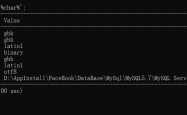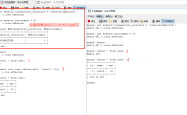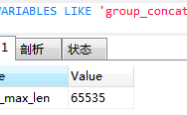详解MySQL的Seconds_Behind_Master
seconds_behind_master
对于mysql主备实例,seconds_behind_master是衡量master与slave之间延时的一个重要参数。通过在slave上执行"show slave status;"可以获取seconds_behind_master的值。
原始实现
definition:the number of seconds that the slave sql thread is behind processing the master binary log.
type:time_t(long)
计算方式如下:
?| 1 2 3 4 5 6 7 8 9 10 11 12 13 14 | rpl_slave.cc::show_slave_status_send_data() if ((mi->get_master_log_pos() == mi->rli->get_group_master_log_pos()) && (!strcmp(mi->get_master_log_name(), mi->rli->get_group_master_log_name()))) { if (mi->slave_running == mysql_slave_run_connect) protocol->store(0ll); else protocol->store_null(); } else { long time_diff = ((long)( time (0) - mi->rli->last_master_timestamp) - mi->clock_diff_with_master); protocol->store( (longlong)(mi->rli->last_master_timestamp ? max (0l, time_diff) : 0)); } |
主要分为以下两种情况:
- sql线程等待io线程获取主机binlog,此时seconds_behind_master为0,表示备机与主机之间无延时;
- sql线程处理relay log,此时seconds_behind_master通过(long)(time(0) – mi->rli->last_master_timestamp) – mi->clock_diff_with_master计算得到;
last_master_timestamp
定义:
主库binlog中事件的时间。
type: time_t (long)
计算方式:
last_master_timestamp根据备机是否并行复制有不同的计算方式。
非并行复制:
?| 1 2 3 4 5 6 7 8 9 10 11 | rpl_slave.cc:exec_relay_log_event() if ((!rli->is_parallel_exec() || rli->last_master_timestamp == 0) && !(ev->is_artificial_event() || ev->is_relay_log_event() || (ev->common_header-> when .tv_sec == 0) || ev->get_type_code() == binary_log::format_description_event || ev->server_id == 0)) { rli->last_master_timestamp= ev->common_header-> when .tv_sec + (time_t) ev->exec_time; dbug_assert(rli->last_master_timestamp >= 0); } |
在该模式下,last_master_timestamp表示为每一个event的结束时间,其中when.tv_sec表示event的开始时间,exec_time表示事务的执行时间。该值的计算在apply_event之前,所以event还未执行时,last_master_timestamp已经被更新。由于exec_time仅在query_log_event中存在,所以last_master_timestamp在应用一个事务的不同event阶段变化。以一个包含两条insert语句的事务为例,在该代码段的调用时,打印出event的类型、时间戳和执行时间
?| 1 2 3 4 5 | create table t1(a int primary key auto_increment ,b longblob) engine=innodb; begin ; insert into t1(b) select repeat( 'a' ,104857600); insert into t1(b) select repeat( 'a' ,104857600); commit ; |
10t06:41:32.628554z 11 [note] [my-000000] [repl] event_type: 33 gtid_log_event
2020-02-10t06:41:32.628601z 11 [note] [my-000000] [repl] event_time: 1581316890
2020-02-10t06:41:32.628614z 11 [note] [my-000000] [repl] event_exec_time: 0
2020-02-10t06:41:32.628692z 11 [note] [my-000000] [repl] event_type: 2 query_event
2020-02-10t06:41:32.628704z 11 [note] [my-000000] [repl] event_time: 1581316823
2020-02-10t06:41:32.628713z 11 [note] [my-000000] [repl] event_exec_time: 35
2020-02-10t06:41:32.629037z 11 [note] [my-000000] [repl] event_type: 19 table_map_event
2020-02-10t06:41:32.629057z 11 [note] [my-000000] [repl] event_time: 1581316823
2020-02-10t06:41:32.629063z 11 [note] [my-000000] [repl] event_exec_time: 0
2020-02-10t06:41:33.644111z 11 [note] [my-000000] [repl] event_type: 30 write_rows_event
2020-02-10t06:41:33.644149z 11 [note] [my-000000] [repl] event_time: 1581316823
2020-02-10t06:41:33.644156z 11 [note] [my-000000] [repl] event_exec_time: 0
2020-02-10t06:41:43.520272z 0 [note] [my-011953] [innodb] page cleaner took 9185ms to flush 3 and evict 0 pages
2020-02-10t06:42:05.982458z 11 [note] [my-000000] [repl] event_type: 19 table_map_event
2020-02-10t06:42:05.982488z 11 [note] [my-000000] [repl] event_time: 1581316858
2020-02-10t06:42:05.982495z 11 [note] [my-000000] [repl] event_exec_time: 0
2020-02-10t06:42:06.569345z 11 [note] [my-000000] [repl] event_type: 30 write_rows_event
2020-02-10t06:42:06.569376z 11 [note] [my-000000] [repl] event_time: 1581316858
2020-02-10t06:42:06.569384z 11 [note] [my-000000] [repl] event_exec_time: 0
2020-02-10t06:42:16.506176z 0 [note] [my-011953] [innodb] page cleaner took 9352ms to flush 8 and evict 0 pages
2020-02-10t06:42:37.202507z 11 [note] [my-000000] [repl] event_type: 16 xid_event
2020-02-10t06:42:37.202539z 11 [note] [my-000000] [repl] event_time: 1581316890
2020-02-10t06:42:37.202546z 11 [note] [my-000000] [repl] event_exec_time: 0
并行复制:
?| 1 2 3 4 5 6 | rpl_slave.cc mts_checkpoint_routine ts = rli->gaq->empty() ? 0 : reinterpret_cast<slave_job_group *>(rli->gaq->head_queue())->ts; rli->reset_notified_checkpoint(cnt, ts, true ); /* end - of "coordinator::" commit_positions" */ |
在该模式下备机上存在一个分发队列gaq,如果gaq为空,则设置last_commit_timestamp为0;如果gaq不为空,则此时维护一个checkpoint点lwm,lwm之前的事务全部在备机上执行完成,此时last_commit_timestamp被更新为lwm所在事务执行完成后的时间。该时间类型为time_t类型。
?| 1 2 3 | ptr_group->ts = common_header-> when .tv_sec + (time_t)exec_time; // seconds_behind_master related rli->rli_checkpoint_seqno++; |
| 1 2 3 4 5 | if (update_timestamp) { mysql_mutex_lock(&data_lock); last_master_timestamp = new_ts; mysql_mutex_unlock(&data_lock); } |
在并行复制下,event执行完成之后才会更新last_master_timestamp,所以非并行复制和并行复制下的seconds_behind_master会存在差异。
clock_diff_with_master
定义:
- the difference in seconds between the clock of the master and the clock of the slave (second - first). it must be signed as it may be <0 or >0. clock_diff_with_master is computed when the i/o thread starts; for this the i/o thread does a select unix_timestamp() on the master.
- type: long
| 1 2 3 4 5 6 7 8 9 10 11 12 | rpl_slave.cc::get_master_version_and_clock() if (!mysql_real_query(mysql, string_with_len( "select unix_timestamp()" )) && (master_res= mysql_store_result(mysql)) && (master_row= mysql_fetch_row(master_res))) { mysql_mutex_lock(&mi->data_lock); mi->clock_diff_with_master= (long) ( time ((time_t*) 0) - strtoul(master_row[0], 0, 10)); dbug_execute_if( "dbug.mts.force_clock_diff_eq_0" , mi->clock_diff_with_master= 0;); mysql_mutex_unlock(&mi->data_lock); } |
该差值仅被计算一次,在master与slave建立联系时处理。
其他
exec_time
定义:
- the difference from the statement's original start timestamp and the time at which it completed executing.
- type: unsigned long
| 1 2 3 4 | struct timeval end_time; ulonglong micro_end_time = my_micro_time(); my_micro_time_to_timeval(micro_end_time, &end_time); exec_time = end_time.tv_sec - thd_arg->query_start_in_secs(); |
时间函数
(1)time_t time(time_t timer) time_t为long类型,返回的数值仅精确到秒;
(2)int gettimeofday (struct timeval *tv, struct timezone *tz) 可以获得微秒级的当前时间;
(3)timeval结构
?| 1 2 3 4 5 | #include < time .h> stuct timeval { time_t tv_sec; /*seconds*/ suseconds_t tv_usec; /*microseconds*/ } |
总结
使用seconds_behind_master衡量主备延时只能精确到秒级别,且在某些场景下,seconds_behind_master并不能准确反映主备之间的延时。主备异常时,可以结合seconds_behind_master源码进行具体分析。
以上就是详解mysql的seconds_behind_master的详细内容,更多关于mysql seconds_behind_master的资料请关注服务器之家其它相关文章!
1.本站遵循行业规范,任何转载的稿件都会明确标注作者和来源;2.本站的原创文章,请转载时务必注明文章作者和来源,不尊重原创的行为我们将追究责任;3.作者投稿可能会经我们编辑修改或补充。










